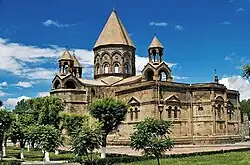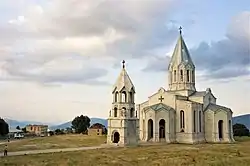| Gandzasar monastery | |
|---|---|
 Aerial view of the monastery in 2018 | |
| Religion | |
| Affiliation | Armenian Apostolic Church |
| Rite | Armenian |
| Year consecrated | July 22, 1240[1] |
| Status | Active |
| Location | |
| Location | near Vankli village, Kalbajar, Azerbaijan |
| Geographic coordinates | 40°03′26″N 46°31′50″E / 40.0572862°N 46.5305449°E |
| Architecture | |
| Style | Armenian |
| Groundbreaking | 1216[2] |
| Completed | 1238[2] |
| Specifications | |
| Length | church: 12.3 metres (40 ft)[3] gavit: 11.8 metres (39 ft)[4] |
| Width | church։ 17.75 metres (58.2 ft)[3] gavit: 13.25 metres (43.5 ft)[4] |
Gandzasar (Armenian: Գանձասար)[lower-alpha 1] is a 13th-century Armenian Apostolic cathedral (historically a monastery) near the village of Vank in the Kalbajar District of Azerbaijan. It has historically been the most important church of Artsakh (Nagorno-Karabakh) since its foundation. One of the finest pieces of Armenian architecture[6][7] of the mid-1200s, the building is best known among scholars for its richly decorated dome.[6][7]
In Azerbaijan, where it is referred to as "Ganjasar" (Azerbaijani: Gəncəsər), the history of the monastery is falsified. Azerbaijan authorities deny its Armenian heritage and instead call it a "Caucasian Albanian temple."[8]
History
Background

The name Gandzasar, which means "treasure mountain" in Armenian, is believed to have originated from the tradition that the monastery was built on a hill containing ores of silver and other metals.[9][10]
The site was first mentioned in written records by the tenth century Catholicos Anania of Moks (r. 946-968),[9] who listed Sargis, a monk from Gandzasar, among the participants of a 949 council convened in Khachen to reconcile Chalcedonian and non-Chalcedonian Armenians.[1] Khachkars dated 1174, 1182, and 1202 have been found around the monastery, which also point to the existence of a church or monastery at the site.[1]
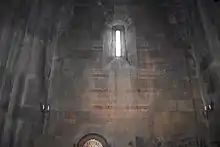
Foundation
The main church was built between 1216 and 1238 by Hasan-Jalal Dawla,[5][2][11] the Armenian prince of Inner Khachen[12] and the patriarch of the House of Hasan-Jalalyan.[13] It was consecrated on July 22, 1240, on the Feast of the Transfiguration (Vardavar) in attendance of some 700 priests.[1] The gavit (narthex), to the west of the church, was started in 1240 and completed in 1266[5] by Atabek, the son of Hasan-Jalal and his wife, Mamkan.[12][11][2] Kirakos Gandzaketsi, a contemporary historian, described the construction of the church in his History of Armenia.[1]
14th-16th centuries
Gandzasar became the seat of the Catholicosate of (Caucasian) Albania, a see of the Armenian Apostolic Church, in the late 14th century.[12] Rouben Paul Adalian considers the foundation of the see a result of an ancient bishopric seeking "ecclesiastical autonomy to compensate for the lack of control and communication from a central pontificate" and part of various local strategies in an Armenia dominated by foreign and Islamic rule to "preserve some semblance of religious authority among the people". In the 16th century it became subordinate to the Etchmiadzin catholicosate.[14]
17th-early 20th centuries
According to contemporary sources, in early 1700s the patriarch of Gandzasar had authority over some 900 villages with hundreds of households in each, composed of peasant and merchant Armenians.[15]
In the 17th and 18th centuries Gandzasar became the center in the liberation efforts by Karabakh Armenian meliks, who were united around Catholicos Yesayi Hasan-Jalalyan (d. 1728).[12][16] He was staunchly pro-Russian and in a 1701 letter signed by Karabakh and Syunik meliks, he asked Peter the Great to protect Armenians from Muslims.[1] However, it was not until the early 1800s that the Russian Empire took control of the region. The Karabakh Khanate eventually came under complete Russian control through the Treaty of Gulistan. Through the 1836 regulation by the Russian authorities, known as Polozhenie, Gandzasar ceased to be the seat of the diocese of Artsakh, which was moved to Shusha.[17] It was gradually abandoned and became dilapidated by the late 19th century.[17]
Soviet period
Gandzasar was closed down by the Soviet authorities no later than 1930.[18] The diocese of Artsakh was reestablished in 1989. Archbishop Pargev Martirosyan was named its primate. Due to his efforts, Gandzasar reopened on October 1, 1989 after six months of renovations.[19] The Soviet government had given permission, while that of Soviet Azerbaijan had not. Gandzasar became the first church to be reopened after decades of suppression. According to Zori Balayan several KGB agents "could [have been] spotted among the crowd attending."[20] Gandzasar served as seat of the bishop before it was moved to Ghazanchetsots Cathedral in Shusha (Shushi) in 1998.[21][22]
First Nagorno-Karabakh War
Gandzasar was attacked several times during the First Nagorno-Karabakh War. On July 6, 1991 Soviet soldiers and OMON (special police) officers raided Gandzasar allegedly in search of guns. They checked papers and conducted a thorough search, including in the graveyard.[23][24]
Fierce fighting took place around Gandzasar in 1992, when Azerbaijan besieged the area. The Armenians broke the siege, which saved Gandzasar and enhanced its spiritual status, wrote Thomas de Waal.[25] On August 16, 1992 some of the outlying buildings within the monastery complex were destroyed as a result of Azerbaijani bombardment by helicopters, which intentionally targeted the church. Corley writes that the attempted bombing of Gandzasar was not of any military importance and that its raid "appeared to be a deliberate attempt to attack the Armenian heritage in Karabakh."[26]
On August 31, 1992 Armenia's Defense Minister Vazgen Sargsyan and Serzh Sargsyan, the head of the self-defense committee of Karabakh Armenians, convened the first meeting of the region's commanders in one of the monastic cells of Gandzasar.[27]
On January 20, 1993 an air strike conducted by two Azerbaijani attack aircraft caused serious damage to the monastery, killed several people nearby and wounded a priest.[24][28]
Restoration and revival
Following the war, the monastery was completely refurbished through the funding of Russia-based businessman and philanthropist Levon Hayrapetyan, a native of Vank.[29][30][31] Restoration works, which lasted from 2000 to 2002, included restoration of the altar, gavit, and tiling of the floor.[32][33] Hayrapetyan also funded the asphalting of the road leading to the church.[18] Some controversy surrounded the tiling of the wall around the monastery in 2011. It was funded by Hayrapetyan and carried out by a company owned by Vladimir Hayrapetyan, his younger brother. While Archbishop Pargev Martirosyan said the wall was not medieval and did not have much architectural significance, therefore tiling was justified, critics argued it was part of the historic complex.[34]
On October 16, 2008 a mass wedding, sponsored by Levon Hayrapetyan took place in Karabakh. Some 700 couples got married on that day, 500 of whom married at Ghazanchetsots Cathedral in Shushi and 200 at Gandzasar.[35][36][37][38] On April 13, 2016 Catholicos Karekin II and Catholicos of Cilicia Aram I delivered a prayer for peace and safety of Nagorno-Karabakh. It came days after the clashes between Armenian and Azerbaijani forces, which were the deadliest since the ceasefire of 1994.[39] The monastery's 770th anniversary was commemorated in 2010 and the 777th anniversary in 2017.[40][41]
It remained under Armenian control after the Second Nagorno-Karabakh War in 2020.
Azerbaijani control
Following the Azerbaijani offensive of September 19–20, 2023, Nagorno-Karabakh was dissolved and the entire population fled to Armenia. In early October 2023, a video posted online showed Azerbaijani police at the monastery.[42][43] Simultaneously, Azerbaijan's State Service of Cultural Heritage issued a statement that claimed that the "Ganjasar monastery" is "one of the most prominent monuments of Christian architecture of Caucasian Albania". It claimed that under Armenian "occupation" it was "vandalized by Armenians" who carried out "illegal repair-restoration".[44] Azerbaijani historian Rizvan Hüseynov claimed the inscriptions have been "falsified."[45] Armenian archaeologist and historian Hamlet Petrosyan and the organization Monument Watch responded to the claims.[46][47] Armenia's representative to UNESCO, Christian Ter-Stepanian accussed Azerbaijan of an attempt to "appropriate and distort the identity of Gandzasar, one of the most famous medieval Armenian monasteries."[48] In a Time article, Christina Maranci warned that its Armenian inscriptions, khachkars, and tombstones are endangered under Azerbaijani control.[49]
Description
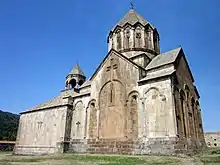
The monastery is located atop a hill, at an altitude of 1,270 metres (4,170 ft),[11] to the south-west of the village of Vank (Azerbaijani: Vəngli) in the province of Martakert.[50] The walled monastery complex includes the church with its narthex (gavit), living quarters, bishop's residence, refectory, and a school building.[50] The living quarters, located on the northern side contain eight cells (2.9 by 2.5 metres (9.5 ft × 8.2 ft)), were built in the 17th century. On the eastern side there is a refectory, built circa 1689. The two-floored school building was erected in 1898. To the south of the monastery walls is the old cemetery, where priests, bishops and notable laypeople (such as meliks) of the areas were buried.[50]
Anatoli L. Yakobson called Gandzasar an "encyclopedia" of Armenian architecture, while Bagrat Ulubabyan and M. S. Asatryan described it as a "jewel".[1]
The monastery consists of a narthex (gavit) and the main church, named for John the Baptist.[5] The church's exterior dimensions are 12.3 by 17.75 metres (40.4 ft × 58.2 ft).[3] The narthex or gavit, measured 11.8 by 13.25 metres (38.7 ft × 43.5 ft),[4][50] is a square-plan hall with two columns near the eastern wall that support the roof. It is very similar to the gavit of the Holy Cross church of Haghpat Monastery.[12][4] The portal on western facade of the gavit is richly decorated.[50]

The main church, named for John the Baptist,[5] has a rectangular, cruciform plan with two-floored sacristies (chambers) on four corners.[12][3][50] In its style, it is similar to the plans of the main churches of Geghard, Hovhannavank and Harichavank, also built in the 13th century.[50][51][52]
The church is prominent for its richly decorated 16-sided cupola.[50][25][28] The bas-reliefs on its exterior depict the Crucifixion of Jesus, Mary with baby Jesus, Adam and Eve, two ktetors (patrons) holding the model of the church, geometrical figures, such as rosettes, head of a bull and an eagle.[12][50][53] The bas-reliefs have been compared to the elaborate carvings of Aghtamar.[54][50]
The interior pendentives under the cylindrical dome in the interior are decorated with geometrical ornaments such as stars, circles and squares, plants such as spiral shoots, palmettes.[3] Each side of the pendentive has high reliefs depicting head of a sheep, heads of a bull and anthropomorphic figures. According to Yakobson, sheep and bulls were considered holy animals in this period and are used as protectors of the structure.[55]
Significance
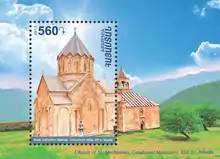
Since its foundation the monastery was for centuries a center of education and manuscript production.[12] It served as the burial place of Armenian princes of Khachen.[56]
Gandzasar is the principal historic tourist attraction in all of Karabakh (Artsakh) and one of the top destinations overall.[57][18] It is also a center of pilgrimage as the region's main historic cathedral both for Karabakh Armenians and tourists (of Armenian ancestry).[25][18] Thomas de Waal noted as early as 1997 that Gandzasar, the most famous church in Karabakh, "has acquired a mythical status in Karabakh."[25] Felix Corley wrote that it is, along with Ghazanchetsots Cathedral in Shushi (Shusha), a powerful symbol of history and identity of Karabakh Armenians regardless their religiosity.[24]
Matenadaran branch
A branch of the Matenadaran, the Yerevan-based museum and research institute of manuscripts, was established at the monastery in 2015.[58][59][60] During the 2020 Nagorno-Karabakh war, the more than one hundred manuscripts kept there were evacuated to Yerevan and displayed at the Yerevan Matenadaran in March 2021.[61][62][63]
Azerbaijani negationism

In the 1970s, Soviet Azerbaijani historians, particularly Rashid Geyushev and Ziya Bunyadov, asserted a negationist theory that postulated that Gandzasar was a Caucasian Albanian monument. They based their claim on the fact that it was the seat of the Albanian Catholicosate of the Armenian Apostolic Church. This theory was adopted and promoted by other Azerbaijani historians, such as Davud Akhundov,[64] and since been adopted by Azerbaijan's authorities. For instance, in 2017, Hikmet Hajiyev, Spokesman for the Azerbaijani Foreign Ministry, stated that Gandzasar is an "Albanian Christian temple, occupied by the Armenian armed forces in the Kalbajar region, is not Gandzasar, but Ganjasar, and has nothing to do with the Armenian Gregorian Church."[65]
Historians who have challenged the Azerbaijani state version of the region's local history, including Victor Schnirelmann, note that Caucasian Albania disappeared in the 10th century, and that the Armenian Church simply adopted the name for its easternmost diocese out of tradition.[64][66][67] Schnirelmann notes that Azerbaijani historians intentionally omit the fact that Gandzasar is a typical example of Armenian architecture of 10th-13th centuries, as well as the numerous Armenian inscriptions on its walls.[64] Thomas de Waal noted that in a 1997 pamphlet titled "The Albanian Monuments of Karabakh" by Igrar Aliyev and Kamil Mamedzade "carefully left out all the Armenian writing" in the depiction of the façade of Gandzasar on its cover.[68] Rouben Galichian notes that Gandzasar, though presented in Azerbaijan as supposedly an "Albanian-Azerbaijani" historic monastery and a part of Azerbaijan's cultural heritage, was left to decay under Azerbaijani control.[69]
Gallery
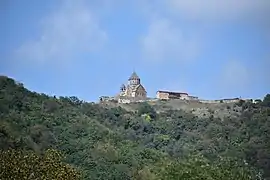 Monastery from the southeast
Monastery from the southeast.jpg.webp) Monastery from the north
Monastery from the north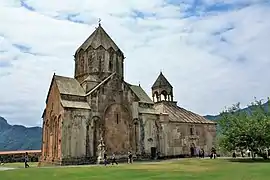 Church from the north
Church from the north Church from the west
Church from the west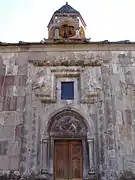 Church door, west facade
Church door, west facade.jpg.webp) Church tower from the northeast
Church tower from the northeast.jpg.webp) Church tower from the northeast, detail
Church tower from the northeast, detail Church tower, Hasan-Jalal Dawla sculpture
Church tower, Hasan-Jalal Dawla sculpture Unexploded ordnance from when the monastery was shelled by Azerbaijani forces on October 29, 1992.
Unexploded ordnance from when the monastery was shelled by Azerbaijani forces on October 29, 1992.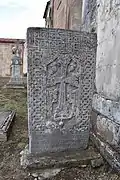 Khachkar of Hasan I, grandfather of Hasan-Jalal
Khachkar of Hasan I, grandfather of Hasan-Jalal Church interior, gavit: marble tombstone of Hasan Jalal Vahtangian
Church interior, gavit: marble tombstone of Hasan Jalal Vahtangian Church interior: foundation inscription
Church interior: foundation inscription Church interior: dome over crossing
Church interior: dome over crossing
References
- notes
- citations
- 1 2 3 4 5 6 7 Mkrtchyan 1989, p. 15.
- 1 2 3 4 Mkrtchyan 1989, p. 14.
- 1 2 3 4 5 Mkrtchyan 1989, p. 16.
- 1 2 3 4 Mkrtchyan 1989, p. 18.
- 1 2 3 4 5 Hewsen 2001, p. 134.
- 1 2 Якобсон, А. (1991). "Из истории армянского средневекового зодчества (Гандзасарский монастырь XIII в.)". К освещению проблем истории и культуры Кавказской Албании и восточных провинций Армении: 447.
- 1 2 Анохин, Г. (1981). "Малый Кавказ". Физкультура и спорт.
- ↑ Шнирельман, В. (2003). Войны памяти: мифы, идентичность и политика в Закавказье. М.: Академкнига. p. 212.
- 1 2 Ulubabyan & Yakobson 1976, p. 686.
- ↑ Mkrtchyan, Gayane (31 August 2007). "A Wonder in Karabakh: A visit to the "mysterious" attraction of Vank". ArmeniaNow. Archived from the original on 2016-08-22.
- 1 2 3 Ter-Danielian 1948, p. 62.
- 1 2 3 4 5 6 7 8 Ulubabyan & Yakobson 1976, p. 687.
- ↑ Hasan-Djalalian, Stepan (2006). "Արցախ-Խաչենի իշխանաց իշխան Հասան-Ջալալ-Դոլան [The Prince of Princes of Artsakh-Khachen: Hasan-Djalal-Dola]". Etchmiadzin. 62 (10–11): 103.
- ↑ Adalian, Rouben Paul (2010). Historical Dictionary of Armenia. Lanham, Maryland: Scarecrow Press. pp. 128–129. ISBN 978-0-8108-7450-3.
- ↑ Ayvazyan, A. M. (2010). "Ժողովրդագրական իրավիճակը Ղարաբաղում 1710-1720-ական թվականներին [Demographic Situation in Karabagh between 1710 and 1720]". Lraber Hasarakakan Gitutyunneri (in Armenian) (1–2): 59–67.; originally published in Ayvazyan, Armen (2001). "The Demographic Situation in Karabakh in the 1710-1720s". Armenian Mind. 5 (1–2): 67–74.
- ↑ Hasan-Jalalyan, S. R. (2011). "Կաթողիկոս Եսայի Հասան-Ջալալյանի քաղաքական գործունեությունն ու պատմագրական ժառանգությունը [Catholicos Yessayi Hasan-Jalalayan's Political Activities and Historiographic Legacy]". Lraber Hasarakakan Gitutyunneri (in Armenian) (3): 82–97.
- 1 2 Ter-Danielian 1948, p. 67.
- 1 2 3 4 Hayrumyan, Naira (1 November 2008). "Recovery and Concern: Regional Unrest Reminds of NKR's Years of Progress, While Raising Anxiety". Armenian General Benevolent Union.
- ↑ Editorial Board (1989). "Գանձասար [Gandzasar]". Etchmiadzin (in Armenian). Mother See of Holy Etchmiadzin. 46 (9–10): 78.
- ↑ Corley 1998, p. 327.
- ↑ "Լեռնային Ղարաբաղի Հանրապետություն: Կրոնը և եկեղեցին [Nagorno-Karabakh Republic: Religion and church]". historyofarmenia.am (in Armenian). Yerevan State University Institute for Armenian Studies.
Առաջին վերաբացված տաճարը Գանձասարի վանքն էր (1989-ին), որն էլ սկզբում դարձել է թեմի առաջնորդանիստը (ներկայումս Շուշիի Ղազանչեցոց Ս. Ամենափրկիչ եկեղեցին է)։
- ↑ Karapetyan, B. "Շուշի [Shushi]" (in Armenian). Yerevan State University Institute for Armenian Studies (via Ղարաբաղյան ազատագրական պատերազմ 1988-1994 (Karabakh Liberation War 1988-1994), 2004, Yerevan: Armenian Encyclopedia Publishing).
Արցախի թեմի առաջնորդանիստ Ղազանչեցոց Ս. Ամենափրկիչ մայր տաճարը (XIX դ.): ... 1998-ին ավարտվել է եկեղեցու զանգակատան նորոգումը և մեծ հանդիսությամբ օծվել հուլիսի 19-ին, որպես հայ առաքելական եկեղեցու Արցախի թեմի առաջնորդանիստ՝ Պարգև արքեպիսկոպոս Մարտիրոսյանի առաջնորդությամբ:
- ↑ Cox, Caroline; Eibner, John (1993). "Operation Ring". Ethnic Cleansing in Progress: War in Nagorno Karabakh. Institute for Religious Minorities in the Islamic World (Christian Solidarity International).
- 1 2 3 Corley 1998, p. 330.
- 1 2 3 4 de Waal, Thomas (15 November 1997). "An Eccentric Outpost of Christianity". The Moscow Times. Archived from the original on 28 February 2017.
- ↑ Corley 1998, p. 331.
- ↑ Janikyan, Grigor (23 May 2013). "Մահապարտների անմահությունը [The Immortality of the Death-Sentenced]". Hay Zinvor (in Armenian). Armenian Ministry of Defense. Archived from the original on 2015-03-23.
- 1 2 Melik-Shahnazaryan 1997.
- ↑ "Hayrapetyan Sentenced to 4 Years in Prison by Moscow Court". Asbarez. 14 April 2016.
- ↑ Pogosyan, Ashot (13 February 2016). "Успешные армяне России: Левон Айрапетян [Russia's Successful Armenians: Levon Hayrapetyan]" (in Russian). REGNUM News Agency.
- ↑ A plaque on its walls reads in Armenian and Russian: "The cathedral, gavit, and the monastic complex was restored by funds of Mr. Levon Hayrapetyan in 1999"
- ↑ "Молодежь призывает Левона Айрапетяна спасти Гандзасар". Yerkramas (in Russian). 6 July 2011.
Гандзасарский монастырь получил новую жизнь в 2000-2002 гг. благодаря средствам московского бизнесмена Левона Айрапетяна.
- ↑ Organova, Natalya (2011). "Гандзасар: война амбиций". noev-kovcheg.ru. No. 15.
«Когда Левон Айрапетян ремонтировал в 2000-2002 годах притвор церкви, когда выкладывал пол церкви плиткой, когда ремонтировал алтарь церкви, где были архитекторы?» – задается риторическим вопросом отец Григор.
- ↑ "Gandzasar facelift: Vandalism or restoration as tiling continues at Karabakh medieval church's fence?". ArmeniaNow. 12 July 2011. Archived from the original on 2012-05-18.
- ↑ "Արցախի Ճերմակազգեստ Գեղեցկուհին [The While Beauty of Artsakh]". hushardzan.am (in Armenian). Service for the Protection of Historical Environment and Cultural Museum Reservations (Ministry of Culture of Armenia). Archived from the original on 1 March 2017.
- ↑ "Karabakh's Big Wedding Day". Institute for War and Peace Reporting. 31 October 2008.
The couples were married in the churches of Gandzasar and Kazanchetsots in Shushi.
- ↑ Hayrapetyan, Anahit (23 October 2008). "Nagorno-Karabakh: Mass Wedding Hopes to Spark Baby Boom in Separatist Territory". EurasiaNet. Archived from the original on 6 April 2018. Retrieved 14 October 2019.
Five hundred and sixty couples ended up being married either at St. Ghazanchetsots church or the 13th century Gandzasar monastery, not far from Vank.
- ↑ "A Memorable Trip to Armenia and Artsakh to Celebrate the ARS Centennial". Asbarez. 24 November 2010.
...the church and monastery of Gandzasar, in the village of Vank, whose benefactor, Levon Hairabedian, a native son, sponsored the weddings of 700 couples in 2008. He also funded the renovation of the church dome and the construction of a seminary next to it.
- ↑ Editorial (2016). "Ն.Ս Օ Տ Տ. Գարեգին Բ. Ամենայն Հայոց Կաթողիկոսի խոսքը Գանձասարի Սուրբ Հովհաննես եկեղեցում (Գանձասար, 13 ապրիլի, 2016 թ.) [Message of His Holiness Karekin II, Catholicos of All Armenians, at St. Hovhannes Church of Gandzassar]". Etchmiadzin (in Armenian). 74 (4): 12–14.
- ↑ "770th anniversary of consecration of St. Hovhannes Mkrtich Church to be celebrated". Armenpress. 2 April 2010.
- ↑ "Foreign Minister Edward Nalbandian attends celebrations dedicated to 777th anniversary of consecration of Gandzasar Monastery in Artsakh". mfa.am. Ministry of Foreign Affairs of Armenia. 27 July 2017.
- ↑ Aghayev, Nasimi (October 5, 2023). "Azerbaijani police officers protecting the Christian sites in Garabagh, including cathedral and church in Khankendi, Ganjasar Monastery in Kalbajar and Amaras Monastery in Khojavend". Twitter. Archived from the original on 6 October 2023.
- ↑ "DİN: Xankəndidə kafedral və kilsə mühafizə olunur". report.az (in Azerbaijani). 5 October 2023. Archived from the original on 16 October 2023.
- ↑ "Azerbaijani State Service: Armenia carried out illegal "repair-restoration" on Ganjasar monastery". apa.az. 4 October 2023. Archived from the original on 4 October 2023.
- ↑ Hüseynov, Rizvan [in Azerbaijani] (4 October 2023). "Баку имеет доказательства фальсификации эпиграфики Гандзасарского монастыря [Baku has evidence of falsification of the epigraphy of the Gandzasar monastery]" (in Russian). Archived from the original on 13 October 2023.
- ↑ Petrosyan, Hamlet (October 4, 2023). "Գանձասարի արձանագրություններում տառ անգամ փոխած չէ [In the Gandzasar inscriptions, not even one letter has been changed]" (in Armenian). Archived from the original on 11 October 2023.
- ↑ "Գանձասարի բռնայուրացումն սկսված է [The expropriation of Gandzasar has begun]". monumentwatch.org (in Armenian). Monument Watch. Archived from the original on 11 October 2023.
- ↑ "Permanent Representative of Armenia delivered remarks at the Executive Board of UNESCO". mfa.am. Ministry of Foreign Affairs of the Republic of Armenia. 9 October 2023. Archived from the original on 12 October 2023.
- ↑ Maranci, Christina (12 October 2023). "What Cultural Genocide Looks Like for Armenians in Nagorno-Karabakh". Time. Archived from the original on 12 October 2023.
- 1 2 3 4 5 6 7 8 9 10 "Gandzasar Monastery". armenica.org. Archived from the original on 13 June 2018. based on "The Architecture of the Gandzasar Monastic Complex" by Murad Hasratian
- ↑ Thierry, Jean-Michel and Patrick Donabédian. Les Arts Arméniens. Paris, 1987.
- ↑ Thierry, Jean. Eglises et Couvents du Karabagh. Antelais, Lebanon, 1991, pp. 161-165
- ↑ Mkrtchyan 1989, p. 17.
- ↑ See Comneno, Lala M., Cuneo, P, and Manukian, S. Volume 19: Gharabagh. Documents of Armenian Art - Documenti di Architettura Armena Series. Polytechnique and the Armenian Academy of Sciences, Milan, OEMME Edizioni, 1980, Introduction
- ↑ Mkrtchyan 1989, pp. 16–17.
- ↑ Carile, Maria Cristina (2014). "Buildings in their patrons' hands? The multiform function of small size models between Byzantium and Transcaucasia".
{{cite journal}}: Cite journal requires|journal=(help) - ↑ Khachatryan, Marietta (1 December 2012). "An Interview with Artsakh President Bako Sahakyan "We Will Do Everything, for the Recognition of Artsakh to Come Soon"". Armenian General Benevolent Union.
- ↑ "President attended the official ceremony of inauguration of the Depository of Manuscripts in Gandzasar". president.am. The Office to the President of Armenia. 21 November 2015. Archived from the original on 10 January 2022.
- ↑ "Մեկնարկել են Մատենադարանի արցախյան մասնաճյուղի շինարարական աշխատանքները". artsakhpress.am (in Armenian). 12 December 2014. Archived from the original on 19 January 2022.
- ↑ "Գանձասարի մատենադարանի բացումը". panorama.am (in Armenian). 21 November 2015. Archived from the original on 19 January 2022.
- ↑ Petrosyan, Sara (3 March 2021). "Gandzasar Manuscripts on Display in Yerevan". Hetq. Archived from the original on 20 January 2022.
- ↑ "Արցախի ձեռագրական արվեստը". matenadaran.am (in Armenian). 3 March 2021. Archived from the original on 14 April 2021. Retrieved 20 January 2022.
- ↑ "Գանձասարի գանձերը Երևանի Մատենադարանում են". 1lurer.am (in Armenian). Public TV of Armenia. 12 March 2021. Archived from the original on 20 January 2022.
- 1 2 3 Schnirelmann, Victor (2003). Войны памяти: мифы, идентичность и политика в Закавказье [Memory wars: myths, identity and politics in Transcaucasia] (in Russian). Moscow: Akademkniga. p. 212. ISBN 5-94628-118-6.
- ↑ "Nalbəndyanın Kəlbəcərə getməsi Ermənistanın münaqişənin danışıqlar yolu ilə həllində maraqlı olmadığını göstərir". news.milli.az (in Azerbaijani). 27 July 2017. Archived from the original on 12 June 2018.
- ↑ "Letter from Karabakh: Quarrels in stone". The Economist. 6 November 1997.
Well, say historians in Baku, up until the 19th century the church at Gandzasar was the seat of one of Christendom's more obscure bishoprics, the "catholicosate of Albania". In the first millennium, Albania was not only a Balkan country but also a realm in the eastern Caucasus. Those sculpted men who built the church and hundreds of others like it were not Armenians at all, the Baku scholars have argued, but Albanians. And the Albanians, they add, were the ancestors of the Azerbaijanis. This is nonsense. According to most historians, the Albanians, a Caucasian people first recorded by the Romans, simply disappeared around the 10th century and became assimilated with their neighbours. All that remained was a territorial name, which the eastern branch of the Armenian church took for its diocese.
- ↑ Hacikyan, Agop Jack; Basmajian, Gabriel; Franchuk, Edward S.; Ouzounian, Nourhan (2002). The Heritage of Armenian Literature: From the sixth to the eighteenth century. Detroit: Wayne State University Press. p. 169. ISBN 9780814330234.
Caucasian Albanian Church became a diocese of the Armenian Apostolic Church and the name Aghvan survived only in the name of this diocese associated with the church and monastery complex of Gandzasar, which was the See of the Catholicate of the Caucasian Albanian Church.
- ↑ de Waal, Thomas (2013). Black Garden: Armenia and Azerbaijan Through Peace and War (2nd ed.). New York University Press. p. 168.
- ↑ Galichian, Rouben (2010) [2009]. The Invention of History: Azerbaijan, Armenia and the Showcasing of Imagination (PDF) (2nd ed.). London: Gomidas Institute. p. 51. ISBN 978-1-903656-88-4. Archived from the original (PDF) on 2017-02-17.
Bibliography
- Corley, Felix (1998). "The Armenian Church under the Soviet and independent regimes, part 3: The leadership of Vazgen". Religion, State and Society. 26 (3–4): 291–355. doi:10.1080/09637499808431832. S2CID 145420788.
- Melik-Shahnazaryan, Levon (1997). "Армянская Культура - Объект Агрессии Азербайджана [Armenian Culture: An Object of Aggression by Azerbaijan]". Военные преступления Азербайджана против мирного населения НКР [Azerbaijani War Crimes Against the Peaceful Population of NKR]. Yerevan: Nairi.
- Ulubabyan, Bagrat; Yakobson, Anatoly L. [in Russian] (1976). "Գանձասար [Gandzasar]". Soviet Armenian Encyclopedia Volume II (in Armenian). pp. 686–687.
- Mkrtchyan, Shahen [in Armenian] (1989). "Гандзасар [Gandzasar]". Историко-архитектурные памятники Нагорного Карабаха [Historical and architectural monuments of Nagorno-Karabakh] (2nd ed.). Yerevan: Parberakan. pp. 14–19.
- Ter-Danielian, M. (1948). "Գանձասար [Gandzasar]". Etchmiadzin (in Armenian). Mother See of Holy Etchmiadzin. 5 (3–4): 62–67.
- Hewsen, Robert H. (2001). Armenia: A Historical Atlas. University of Chicago Press. ISBN 0-226-33228-4.
Further reading
- (in Russian) Yakobson, Anatoly L. "From the History of Medieval Armenian Architecture: the Monastery of Gandzasar," in: Studies in the History of Culture of the Peoples in the East. Moscow-Leningrad. 1960.
- Գանձասարի վանքի նորահայտ արձանագրությունը Archived 2021-04-10 at the Wayback Machine
- Արցախի հոգևոր թեմի պատմությունը վավերագրերում (1813-1933) Archived 2021-05-25 at the Wayback Machine
